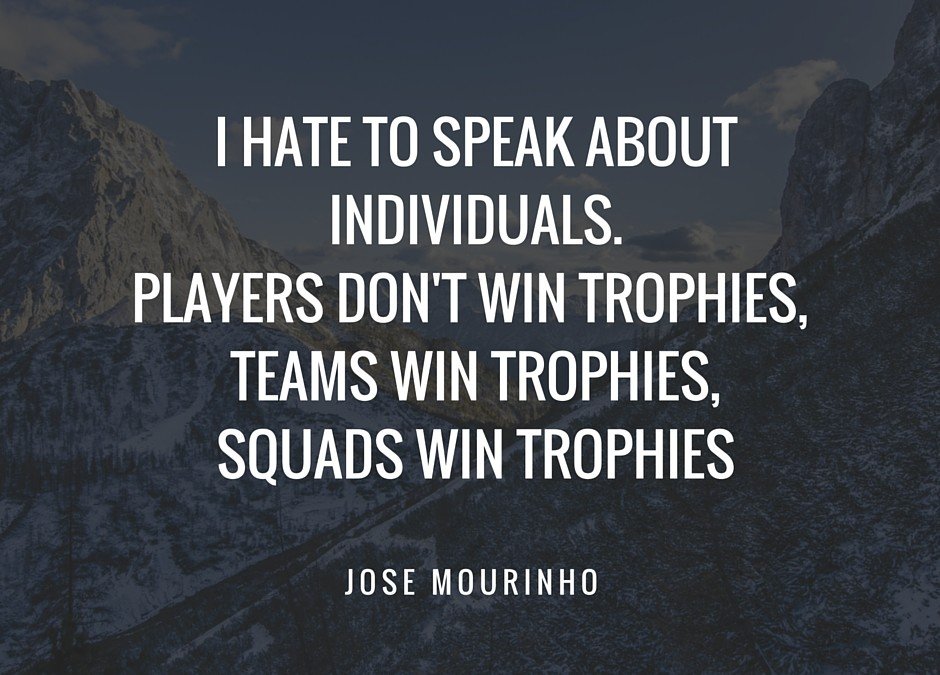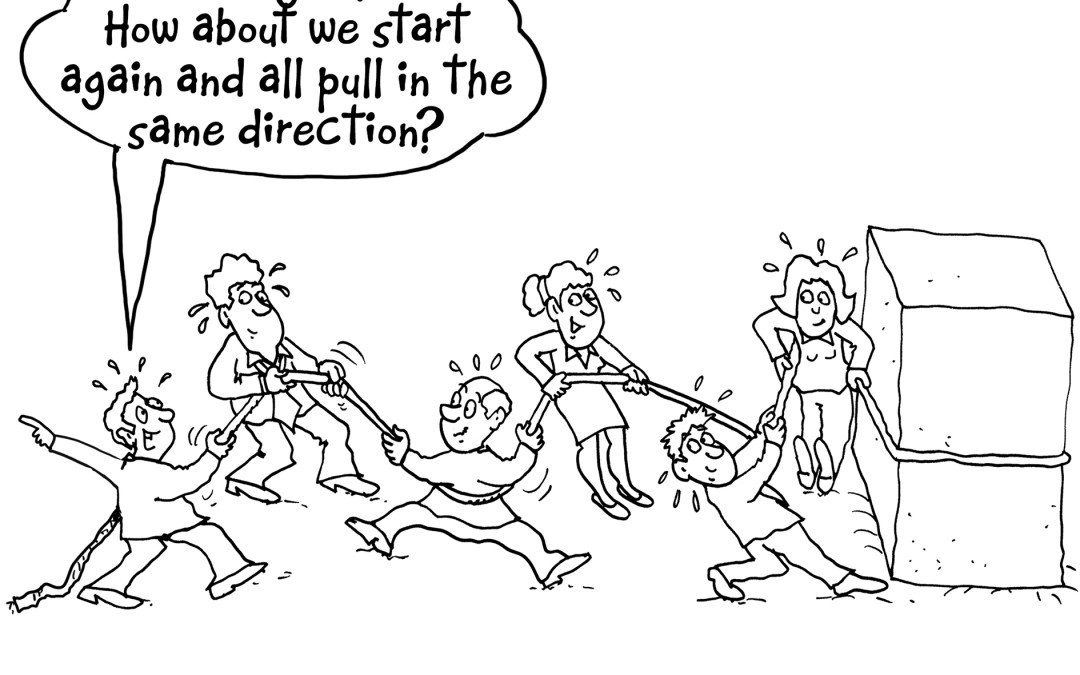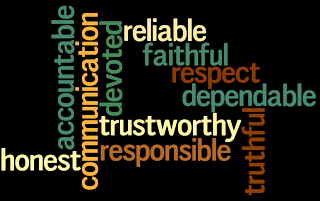
by Julia Felton | Jan 9, 2016
Success is a team sport and it is imperative that you have the right team members alongside you to create a winning team. Now I know when you are starting out in business having a team might seem like a luxury, but trust me it is the best investment you can make.
Having a team helps you feel supported and no longer alone. The curse of the business owner is feeling like they have to do it all themselves, whilst the opposite is in fact true. Surround yourself with team members who excel at the activities you don’t. It will make your life so much easier and allow you to spend time doing the things that you love and that add real value to the business.
And if you’ve ever like to add me to your team then let me know and we can schedule a complimentary strategy session to see if we would be a good fit for each other.
Just like any successful sports team, your team members must gel together if you are to really leverage the full benefits of teamwork.

by Julia Felton | Nov 27, 2015
Just because you have the title of leader doesn’t make you are a leader. And just because you don’t have the title of leader doesn’t mean you aren’t a leader. To my mind everyone in the organisation is a leader which is why in my new book The Alchemy Of Change: The Key To the Future Lies In The Past I explore the concept of Shared Leadership.
So what is Shared Leadership?
Shared Leadership is the concept that, given the rapidity of change, there is no way one person can know about everything in the business. For a business to be successful, leadership and decision making needs to be shared.
The old paradigm of command and control leadership simply won’t serve us in this The Big data era, where collaboration is a necessity. There is simply too much going on for one leader to be able to manage it all. This in itself creates blind spots for businesses, which is why a more flatter, more collaborative style of leadership, which is more responsive is required.
When Shared Leadership is adopted within the organisation then everyone looks out for the needs of the businesses, not in a self-serving ego way, but from a place of contribution to the community. Everyone is focused on the goal and works as a team to achieve this. It always surprises me that business has not taken a leaf from the world of sport. In a sports team there is no place for individual performance. Success only comes from the collective performance of the team.
The famous basketball player Michael Jordan knew this when he said: “Talent wins games but teamwork and intelligence wins championships”. Michael understood the power of collaboration and how only by all team members working together could the team win the game.
Interestingly, herds of wild horses also understand the power of Shared Leadership. The herd is structured with two leaders – the lead mare and the stallion – and they work in collaboration to keep the herd safe. They seek out food, water and shelter for the herd but the herd members do not solely rely on the leaders to keep them safe. Every herd member has a responsibility to maintain the safety of the herd and so contribute to its survival.
The herd has a shared purpose and focus, which quite simply is to stay alive. As a prey animal the horses main challenge is how to avoid being someone else’s dinner! It is this shared purpose and vision which enables the herd to become self regulating. There is no space in the herd for self-serving members and in fact they are driven out of the herd. This is the worst punishment ever because being evicted from the herd means that you are all alone, and this is not a safe place to be because its challenging to protect yourself when you are isolated from others.
So when is business going to wake up to the need for Shared Leadership? I wonder how much more productive and profitable an organisation could be if everyone was working from the same page towards the same goals and where the result of the team was more important than that of the individual.
The 2010 Burston-Marsteller?IMD Corporate Purpose Study revealed that organisations that focused on having a strong well communicated corporate purpose that everyone in the business got behind delivered a 17% improvement in financial performance compared to those organisations that didn’t. Wow, what a load of resources are being wasted in business simply because of the self serving stance that many people are taking.
Imagine the possibilities if everyone in business worked more effectively together as a high performing team. I wonder what we all could achieve.
If you’d like to learn more about the principles of creating a high performance business with Shared Leadership then please connect with me for a complimentary consultation.

by Julia Felton | Oct 1, 2015
When you type the phrase ‘inspiring leaders’ into Google, the results are most likely what you’d expect — images of Steve Jobs, Martin Luther King, Mahatma Gandhi and Nelson Mandela. But have you ever stopped to consider why these usual suspects show up time and time again in conversations about inspiring leadership, and what they might have in common, in terms of the way they think, act and communicate?
One of the most popular TED talks of all time, given by leadership expert Simon Sinek, considers this very question. With almost 20 million views, there are clearly many people who want to understand what it takes to lead in a way that inspires others, and why it is that some organisations and some leaders are able to inspire where others aren’t?
In his talk, Sinek claims to have discovered a pattern between these leaders, which he has codified into an idea called the ‘golden circle’.
“Every single person, every single organisation on the planet knows what they do, 100%. Some know how they do it, whether you call it your differentiated value proposition or your proprietary process or your USP. But very, very few people or organisations know why they do what they do…By “why,” I mean: What’s your purpose? What’s your cause? What’s your belief? Why does your organisation exist? Why do you get out of bed in the morning? And why should anyone care?”
Core to Sinek’s ‘golden circle’ principle is the idea that “people don’t buy what you do; they buy why you do it.”
Apple
Citing Apple as a shining example, Sinek attributes the brand’s success to its ability to get people to believe in what it does by communicating why they do things the way they do. So rather than saying “we make great computers — want to buy one?”, Apple has always placed emphasis on communicating from the inside out, clarifying why it builds the products it does.
According to Sinek, Apple says: “Everything we do, we believe in challenging the status quo. We believe in thinking differently. The way we challenge the status quo is by making our products beautifully designed, simple to use and user friendly. We just happen to make great computers. Want to buy one?”
The science
Sinek bases his theory upon scientific fact, and specifically, the biological make-up of the brain, which he says corresponds directly to his ‘golden circle’ rule.
A cross-section of the brain has three major components. The neocortex (on the outside) is responsible for all of our rational and analytical thought and language. Our limbic brains (the middle two sections) are responsible for all of our feelings, like trust and loyalty. They are also responsible for all human behaviour, all decision-making, and have no capacity for language.
So, according to Sinek, “when we can communicate from the inside out, we’re talking directly to the part of the brain that controls behaviour, and then we allow people to rationalise it with the tangible things we say and do. This is where gut decisions come from.”
For a business having a clear purpose, a clear Why, is essential to give the business direction. The business Why acts like a true north compass steering the business towards success, Without knowing where you are going the business can end up stalling and at best going round in a circle. Being busy but achieving little.
A clear business Why is also of paramount importance as it helps engage the mind and soul of team members who want to innately contribute to a bigger purpose. When everyone is on the same page then as the organisation is able to start unlocking some of its hidden potential. Why? because team members give more of themselves when they acknowledge they are committed to a vision bigger than themselves. In the words of Sinek, “Whether they’re individuals or organisations, we follow those who lead, not because we have to, but because we want to. We follow those who lead, not for them, but for ourselves.”
So if you haven’t already, ask yourself why you do what you do every day. Once you can answer that with conviction, you’ll be more likely to hire team members who share your beliefs and win the trust and loyalty of those whom you lead, whilst sprinkling a bit of inspiration along the way.
Creating a solid Business Promise (Why) is a key facet of one of the three cornerstones of creating a Joined Up Business and that is explained in my book the Alchemy Of Change: Ancient Wisdom Re-invented to Unleash the Potential Of Leaders and Team. You can get a copy here.

by Julia Felton | Sep 22, 2015
Your flow comes from following your natural path. Your team momentum comes from each team member following their natural path. Each frequency and each profile has a different role within the team where they can be most effective. Often the best team selection is not the person who can be most effective, but the person who enables the existing team to become more effective.
Here are the 8 profiles, and the role within the team that allows them to be in their greatest flow:
Creator: The initiator
Creators are the best initiators, and although they can be quick to create chaos, they can also be surprisingly innovative at finding ways out of chaos. Always put them in charge of new projects, but move them on to the next creation once their job is done.
Star: The promoter
Stars are the best promoters, but need to lead from the front. Give them the chance to shine, and give them the space to deliver results without tying them down. Give them the systems and support to enable them to focus on building new business.
Supporter: The leader
Supporters are the best leaders, but don’t expect them to come up with the plan. Build a plan and set the goals with a Supporter, and then let them lead the team towards the plan. Let them set their own management style, and their own agenda.
Deal Maker: The peace maker
Deal Makers are the best peacemakers, and will leave everyone feeling good. Don’t expect them to go out cold calling, as they thrive on building the relationships they have. Work with Deal Makers to nurture the customer and relationships you have.
Trader: The negotiator
Traders are your best negotiators. They will always get you the best price, in both what you buy and what you sell. They want to be given the parameters in which to work. Traders will have their ear to the ground in your market and your team.
Accumulator: The ambassador
Accumulators are your best ambassadors. They are reliable, get things done on time, and are not prone to making rash decisions. Accumulators make the best project managers, when a specific task needs to be delivered reliably.
Lord: The analyst
Lords are your best analysts. Give them the space to study the detail, and to deliver the data. Don’t ask them to go out and network, as they are strongest when focused behind the scenes.
Mechanic: The completer
Mechanics are your best completers. They will wrap up the process and find smart ways to do it better next time. Don’t ask a mechanic to start from scratch, but do give them an existing process or product to improve on.

by Julia Felton | Apr 7, 2015
Trust is not an abstract, theoretical, idealistic goal forever beyond our reach. Trust—or a lack of it—is inherent in every action that we take and affects everything that we do. Trust is the cement that binds relationships, keeping spouses together, business deals intact and political systems stable. Without trust, marriages fail, voters become apathetic and organizations flounder. Without trust, no person or company can ever hope for excellence.
The truth is, trust must be carefully constructed, vigorously nurtured and constantly reinforced. Although it takes a long time to develop, it can be destroyed by a single action. And once lost, it is exceptionally difficult to re-establish.
Over the years horses have taught me much about how to build trust. The best lessons probably came from Bunny and Red, two rescue horses that were terrified of people. In order to build their trust I had to demonstrate consistent, credible behaviour. I had to do what I told them I would do, continually following through and also rewarding and acknowledging them for every action they took that enhanced our relationship. The truth is that it took a long time to build trust with these horses, but once formed we had an amazing relationship that still exists today. However, I am all too aware of how fragile that trust is and how easily it could be lost.The same principles for building trust with the horses can be applied to building more trustful relationships in business. Here are 14 things to remember when building trust, adapted from
Follow Your Conscience by Frank Sonnenberg:
1. Be straight with people. Tell it like it is.
2. Don’t be afraid to present bad news. It’s worse to sweep it under the rug.
3. Remain calm, cool and collected during difficult times.
4. Present both sides of an issue. (Let them judge for themselves.)
5. Be a good listener.
6. Disclose potential conflicts of interest.
7. Even a tiny exaggeration can destroy your credibility.
8. Always tell the truth or the truth will tell on you.
9. Your actions “off-stage” (like at an office party or on Facebook) impact your trust and credibility.
10. “Everybody does it” is a poor excuse for doing it yourself.
11. Learn how to disagree without being disagreeable.
12. Repeating a rumor is as vicious as starting one.
13. People will test you in small ways before trusting you outright.
14. The only thing worse than talking about others is talking about yourself.
If you’d like to learn how to build trust in your organisation then I’d be happy to talk with you because it has been shown that the higher the levels of trust in business the more profitable and successful the business can be.
Want to find out where you are most trusted in business, then take the free assessment here.

by Julia Felton | Mar 24, 2015
Trust “is both a mindset and a toolbox for 21st-century leadership”. Robert A. McDonald, Chairman, President and CEO, The Procter & Gamble Company
In today’s networked world, Trust has become the new currency – the critical competency for individuals, teams, organisations and even countries. Trust impacts every situation and relationship whether personal or professional.
Trust acts like a lubricant. It reduces friction and creates conditions for evolving high performance teams. How well the team works together is the true indicator of future success or the ability to manage through the struggle of relentless change. Without trust there would be no harmony in the team and business and dis-ease would prevail.
When we work in a high trust team things get done quicker and more easily. There is less conflict, less back-stabbing, less politics and more time spent on value added activities like innovative and customer service.
However, trust within teams does not happen overnight. As Joachim Low, the winning German Football Team World Cup coach noted “We’ve been together now for 55 days. We started this project 10 years ago, so this is the result of many years’ work, beginning with Jurgen Klinsmann. We’ve continued that work and our strength has been our constant progress. We’d not made this ultimate step before, but champions do what they will do. We believed we’d win it. We’re looking back over ten years of preparation and hard work. This team has developed a spirit which is unbelievable. We’re proud to be the first European team to win a title in Latin America, in Rio, in Brazil, in a footballing country par excellence… and this makes us proud.”
So what are the four key actions that team members must cultivate if they are to build and maintain trust with their fellow team members:
Commitment
Commitment is an important part of building trust. Every team member must acknowledge they play an important role in creating the success of the team and helping it achieve its goals. When one team member fails to deliver it has a knock on effect on everyone else in the team. This is why no matter if personal or professional obstacles present them team members must seek ways to keep their commitment to the team. Just as they need to rely on others, others must be able to rely on them.
Competence
Team members must trust that their teammates are competent and can successfully complete the tasks relevant to the team’s success. For example, each team member should be able to focus on an assigned task without worrying about teammates following through with their assigned tasks. Individual team members must realize when they need help and ask for it, instead of concealing weaknesses from the group. When team members show vulnerability to their teammates and the teammates respond in an efficient and helpful manner, trust will grow between them.
Communication
Consistent and meaningful communication is necessary for building a trusting relationship within a team. For instance, if a team member finishes a task early, they should communicate to their teammates that they are finished and ask if they can help another team member with their part of the work. If one team member discovers vital information that is relevant to the team’s success, such as a deadline change or a lack of resources, they should communicate it to the other members as soon as possible.
Collaboration
True collaboration won’t happen without a sense of trust between team members. When team members collaborate, they share creative ideas without fear that another team member will take credit for their ideas. Through collaboration innovative ideas are born. It is definitely a case of 1+1=3. When team members trust each other they are more likely to show their vulnerability, which in turn will build more trust within the team.
In summary trust anchors every successful team. When team members demonstrate commitment, competency, communication and collaboration then others will trust them and superior performance will result both in terms of productivity and profitability. However, when a team is forming who do you trust? In the words of Ernest Hemingway “The best way to find out if you can trust somebody is to trust them.”. Building trust is a two way street as you need to give trust in order to get it.

by Julia Felton | Jan 27, 2015
Whether you are a business owner or an employee it is essential that you find the right person or job role that is a match for you. I know given the tough economic conditions we’ve been through recently that it is tempting for a candidate to apply for any job for and for recruiters who needs to find resource to accept a less and ideal candidate.
Stop. This is such a flawed strategy for both parties and ultimately ends up costing everyone valuable time, energy and money as:
- The candidate ultimately won’t enjoy the job. Sure they might be able to do the role, but are they giving 110% to it. If the role is not aligned to their own passion and purpose they simply won’t be as productive or creative in the role as they could be.
- For the business owner they are not utilizing the team members best strengths and so ultimately the productivity and engagement of the team member declines and the net result is less profitability for the business.
What both parties crave for is a situation where the team member is working to their strengths, and delivering massive value to the business . This occurs when the team member is in a state we call flow. Put simply, flow is the path of least resistance. When team members are in flow, productivity rises, results increase, occurrences line up, everyone has more fun and feels more connected to the organisation and it’s goals.
When a team member is in flow they feel energised, focused and fully engaged in the task at hand. Often there can be a distortion of time as their internal clock does not seem to match the external clock – perhaps you have experienced this when you have been doing something you love and time just literally seems to fly by. That’s a time that you were in flow.
So how do you know if you are in flow:
- If you are feeling stressed, overwhelmed or anxious, then it’s a fairly good indicator you are out of Flow.
- The opposite is true when you are in Flow, you feel joy and even rapture whilst performing the task. In the work place, this results in a harmonious environment.
The challenge I come across time and time again are team members that are in the wrong roles. They are not playing to their strengths and as a result the are sabotaging the success of the business. This is not usually intentional it is just that unless you are in flow you are unlikely to be able to access the hidden 90% of your potential that exists.
Imagine the benefits if all your team members were operating at or above their peak performance level. Imagine what an impact that would have both on the motivation of the employee but also on the organizational results. Customers would feel more cared for, projects would get delivered on time and the harmony in the workplace would be infectious. This is the type of workplace where trust pervades as everyone is doing their role to their very best.
One tool that I use to help my clients and their business get into flow is something called Talent Dynamics. Based on an ancient Chinese philosophy, the I Ching, it allows each person in a team or organisation to understand the quickest and easiest way for them to get into and stay in Flow by working with their strengths. It also helps them understand where they are most able to add value to the organisation. Simply, by understanding the value you contribute to a team, then you can immediately help identify potential Business Development opportunities.
If you manage a team then by profiling your whole team you can create mutual understanding and get the whole team into flow. Understanding the strengths of team mates and how they contribute and add value to the business allows you to better communicate and it is easier to gain trust and respect with each other and so deliver results in performance and profitability.
So whether you’re a business owner or a candidate make sure that you find the perfect role for you – one that speaks to your strengths and where you can add real value.
The first step to finding out your strengths is to identify where you are most trusted in business. You can take the quick 30 second assessment at http://bit.ly/trusttest.

by Julia Felton | Nov 19, 2014
“There’s no such thing as a self-made
millionaire. Only TEAM-made millionaires”
Teamwork is to my mind the most effective way in business to create success. Being in business is tough and there is simply no way that you can do everything by yourself. Each of us has own our brilliance and working with team members enables you to focus on your brilliance whilst letting others do theirs. The net effect is that everyone is in a state called flow, which is the state of least resistance. Then business becomes easy and fun.
But how do you get the best out of team members and inspire them to give of their best to help your business grow and be successful.? The answer is to ask better questions. So are you a teller or a questioner?
In other words, when you’re working with your team members (or outsourcers) do you tend to tell them what to do or do you engage them in a conversation by asking questions?
If you’re like most entrepreneurial leaders, chances are you’re the former. If that’s true, then my question to you is “How’s that working for ya?”
My guess is it’s not working out as great as you’d like it to. In fact, I find that most entrepreneurial leaders are pretty frustrated with the people they’re “leading.” See if any of the following statements ring true for you
- “They never do what I tell them to do!”
- “It always takes her ten times longer to do what I asked her to do. If she’d just listen to me, she could get it done in one tenth of the time it’s currently taking!”
- “I can’t understand why it’s taking him so long to do what I asked him to do.”
- “I can’t figure out why she just can’t follow my directions.”
- “I didn’t hire him to think. I hired him to do what I tell him to do.”
Ouch! And I fully understand those sentiments. As an entrepreneurial leader myself I understand why you want people to do what you want them to do in the way you want them to do it (after all, you are the BOSS, right? And it is YOUR company. And you do pay THE BILLS. And they do work for YOU, right?).
Furthermore, I get the whole driven part of the entrepreneurial personality. According to Talent Dynamics I have lots of dynamo energy so, by personality, I like being a teller. I like saying, as chances are you do, “Here’s what I want you to do. Now, just go do it. No questions. No debate. Just get it done EXACTLY how I told you to do it.”
But, as you well know, that approach doesn’t produce the best results
The Problem With Being a Teller
What I learned, and hopefully you are as well, is that being a teller is a counterproductive leadership approach. Why? For a number of reasons. I’ll give you three.
1. Telling doesn’t create buy in. As you know, people own what they help create, which, by definition means they don’t own what they don’t help create. So, if you or I say, “Billy, I want you to do X in Y way,” how much does he own that? Virtually nil. And if someone doesn’t own a task or project or process/procedure or event or strategy or tactic, the chances of them producing the best result will always be lower than if Billy is involved in creating the solution. Telling doesn’t work because it doesn’t create buy in or ownership.
Note: We’re not talking about following systems here. We’re talking about solving problems or creating something new.
2. Telling doesn’t produce the kind of people you want/need. In other words, if you’re a teller, you’re NOT developing your people to be their best (whether that’s to be a better leader or problem solver or innovator or coach or process person, etc.). Or to put it another way, if you or I are always in the telling position, then we’re not creating independent thinkers. And if we’re not creating independent thinkers, then we’ll have to keep doing all the thinking—which leads to the third reason why you don’t want to be a teller.
3. Telling doesn’t create leverage. If you or I still have to do all the thinking, then we’re not creating leverage. We’re simply creating more work for ourselves. We become the bottleneck to growth. If our people don’t own the task, then we have to invest more time in managing and leading the task. If our people aren’t really excited about a task or project, then more conflict will occur, which means we’ll have to invest more time. Or, if the only people we’re happy with are people who will just do what they’re told, then we’ll always put a lid on the quality of the kind of employee we can hire (which, again, kills leverage).
Any way you add it up, being a teller, just isn’t the smartest leadership choice you or I can make if we want to grow a fast growing business or organization.
The Better Option
The better option, if you want to get the best from your team is to learn to connect, engage and communicate with them. Even if this isn’t your natural bent, you can learn to do this. In fact, the reason I’m writing this post today is because one of my clients said to me this week—when we were discussing an employee situation and I was role-playing out the conversation for him, “Julia, one of the things I appreciate about you is that you’re so good at asking questions. I’m not. That’s just not how I’m wired.”
To which I responded, “Thanks for the compliment, but I’m not wired that way either.” Learning to use questions to lead isn’t a natural ability for most of us, it’s an acquired skill. And it’s not that hard to do on a skill level, it’s only hard on an implementation level. So, here are a few ideas to help you get started on unleashing your inner questioner.
1. Learn to see yourself as a developer of talent, not a boss. At the end of the day, most of us like to be tellers because we see ourselves as “the boss.” When we own the boss hat, most of us like to be in the teller role (I hired you. I pay you. Do what I tell you to do). And as long as we own that mindset, we’ll struggle with asking questions. However, if you can make the mental shift from boss to talent developer, you’ll begin to see your role completely differently (which is key because talent developers create leverage, whereas bosses don’t).
2. Make questioning your first response. I know this may feel pedantic, but when someone asks you a question, ask them a question back. Refuse to just give the answer (something that most of us who are male will always struggle with :-). Instead, when someone asks, “So, what do you think I should do?” throw it back to them, “First, tell me what you think you should do?” If they say, “I asked you first.” Just respond, “Well, how do you think I’d respond?” Return question for question. As hard as this is, don’t give the first answer.
3. Open your team conversations with questions. Instead of saying, “Taraji, we have a problem here. And here’s what I want you to do.” Open the conversation with a wide open question. “Tariji, as you know, we have a problem here. What do you think is creating it?” Or, “What’s your best thinking about how to solve this?” Or, “Do you have any ideas about how we can eliminate this in the next 30 days?”
Yes, there is an art to asking good questions (for example, wide open questions are better for creating independent thinkers), but what’s more important is that you embrace the principle that being a questioner is a better leadership choice than being a teller. Once you do that, you’ll acquire the skill set over time through trial and error. But you’ll never get there if you don’t embrace this concept as a core leadership practice.
So do you? Do you really believe that being a leader who leads through questioning is better than being a leader who leads by telling? I hope so because the choice you make will have profound consequences for you and your company for years to come. So, choose wisely! Remember,
“If you want to get the most from your people, then you need to draw the best that is in them—out of them.”
By the way, if you’re thinking, “But asking questions sure takes a lot more time than telling,” then you probably don’t own the idea that a leader isn’t a boss, a leader is a talent developer who leverages the time, talent, treasures, resources, intellectual property and connections of their people to produce a result.
Oh, and one last thought. This practice is irrelevant to size. It doesn’t matter if you’re leading a two person team or a two thousand person team, the same principle holds.
Go forth and ask better questions.

by Julia Felton | Sep 26, 2013
Step 6 in creating a Joined Up Business is resource effectively and to do this you need a Joined Up team. So many entrepreneurs I see are struggling to harness more clients and cash because they are the centre of the business as a result the business cannot grow. I have always said that success is a team sport as so if you want to up level your business you need to bring valuable team members. Yet time and time again I see people making poor decisions regarding the resources they need. So why is this? The reason is that often we like to hire (engage the services) of people like us but that is the death knell for a small business. People like us like the same tasks that we like so the result is that the other tasks (the ones we hate and procrastinate about) never get completed.
I m sure many of you are familiar with the wheel of life. You map all the areas of your life and aim to get everything in balance because only if the wheel is in balance can it turn effectively. On the way to the airport this morning I had a stark reminder of what happens when things get out of balance because I got a flat tyre. Being out of balance – with only three tyres – meant I could not go forward and so had to pull over onto the hard shoulder of the motorway. And the only way to efficiently and effectively get me moving again was to summon in support in the form of the Green Flag man. He came and changed my tyre for me so I could get going again. It was a really great analogy for me of how often the same thing happens in business. We forget to focus on an area until it goes wrong and then we either have to try and fix it ourselves or find support and team members to get this challenge resolved.
So how do we find the right people to work with us in our Joined Up Team ? How do we identify individuals that we can work with who can add real value to our business. Well the trick is not to hire people like us but rather the opposite because these people will love doing the tasks we hate. The tool I use to help me determine the right person to hire is Talent Dynamics. This short assessment helps people identify their natural strengths and so reveals the areas of business where they can add the most value because they are in flow. So what is flow? Flow is the state we are in when time flies by and we love what we are doing. Everything seems easy, yet time and time again I see business owners stepping out of flow because they seem to think that business should be hard. They fail to realise that they are delivering the most value when they are doing what they love and things are easy.
Within Talent Dynamics there are 8 different archetypes and you can read all about them here. Each archetype has different strengths and activities that they are best suited to work on in a business. Maybe you have high dynamo energy like the creators – they have their head in the clouds and are great at strategy and creating new ideas but lousy at follow up and detail. Contrast this with the traders (tempo energy people) who love detail and have their ear to the ground. They love to know what is going on and are great at detail. Give them customer facing roles where they can nurture the clients and they will flourish.
Then there are blaze energy people who just love connecting with others. It’s all about the people for them so they are great at networking, deal making and raising the visibility of your business. In contrast steel energy people are all about the task and analytical detail. The process is more important for them than the people so these people relish roles like accountancy and finance that are meticulously detailed. It’s important to note that we all have our unique energy blueprint and can all “do” all the energies but you will be more efficient, productive and therefore happy if you focus on the activities that you have the greatest affinity and propensity to excel at.
Once you understand where your strength and talents lie it is easy then to hire people with complementary skills. In doing so you create a Joined Up Team that is balanced and gets all the tasks of he business accomplished. You can take your talent dynamics test here and if you need any help in creating your Joined Up Team just let me know and we can schedule a Joined Up Business Strategy Session to jump start your business to the next level.

by Julia Felton | Nov 14, 2012
I came across this 1928 article (anonymous) called ‘10 Ways to Kill a Team’. I smiled as a I read it and thought you’d enjoy:
- Don’t go to team meetings. Complain about the inconvenience of scheduling – place – time.
- If you do go, go late and offer a creative excuse. Do create distractions when arriving.
- If the weather doesn’t suit you, don’t even think of going. It’s not convenient anyway.
- If you attend, find subtle fault with the work of the team leader and team members.
- Never accept leadership as it is easier to criticise than to do things and take the heat.
- Get sore if you are not appointed to special teams, but if you are, don’t participate.
- If asked by the team leader for your opinion, don’t give it – complain after the meeting.
- Do the minimum, when others jump in to help, complain that a clique runs the team.
- Don’t pay your dues or coffee / birthday / anniversary fund collections, or pay very late.
- Don’t recruit new members, “Let George do it”. Complain about quality and production.
Do you know anyone who does these things?!
If any of these resonate then I would strongly urge you to look at your team and how to engage them in your business. One great way to do this is to get your team members to take a Talent Dynamics profile test. You can take the test here.














